8
TRANSPORTATION AND TRADE
Domestic Trade
From 1992 to 1998, the value of domestic trade (goods and services)
rose from $1,071 billion to $1,354 billion (in current dollars).
This implies that, after the recession of the early 1990s, the
value of domestic trade increased at an average annual rate of
four per cent over this period. In constant (1992) dollars, however,
this annual average growth is reduced to 2.7 per cent. As explained
later in this chapter, this growth in domestic trade is modest
when compared with that of external trade over the same period.
Intraprovincial trade flows dominated domestic trade, in a
ratio that remained relatively constant over the 1992-1998 period,
with intraprovincial trade at 87 per cent of total domestic
trade and interprovincial at 13 per cent. In terms of
goods and services, the share of domestic trade for services was
constant at 74 per cent, while that for goods levelled at 26 per
cent.
Figures 8-1 and 8-2 show Canada's domestic trade by type
and sector from 1992 to 1998.
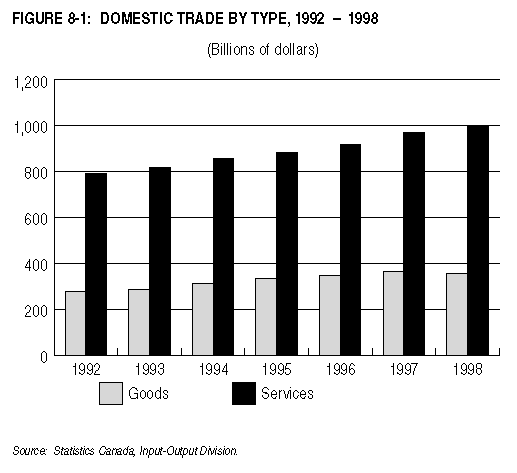

Composition of Trade
Goods and services generate different needs in transportation.
From 1992 to 1998, the value of services traded rose from $792
billion to $996 billion, a 3.9 per cent average growth. Over 90
per cent of services were traded intraprovincially. In 1998, major
domestic services were related to business and finance ($206 billion),
the government sector ($190 billion), wholesale and retail trade
($125 billion), construction ($106 billion) and transportation
($66 billion).
The value of goods traded domestically rose from $278 billion
to $358 billion, representing an average annual growth of 4.3
per cent. Fabricated materials and manufactured goods represented
nearly 80 per cent of total domestic trade, while primary goods
and crude materials accounted for the rest. Over 70 per cent of
total domestic trade in goods was intraprovincial.
Table 8-1 presents the value of domestic trade by sector and
type of commodity for 1998.

Transportation by Mode
From 1992 to 1998, the volume carried by various modes increased
by an average of three per cent, from 362 million to 429
million tonnes. Rail accounted for the greatest share, oscillating
between 46 and 50 per cent of total tonnage moved. For-hire truckingNote
3 followed closely, increasing its share from 34 per
cent to 41 per cent. Marine's share declined slightly, from 14
to 11 per cent. Air carried less than one per cent.
Table 8-2 shows that in 1998, 429 million tonnes were moved
within domestic borders. Rail and marine realized over 70 per
cent of their activity in the shipping of primary goods and crude
materials, while for-hire trucking realized about the same but
in manufactured goods and fabricated materials. Container shipping
accounted for less than one per cent of domestic marine tonnage
and seven per cent of that for domestic rail.

The trucking share would be higher if traffic activities of small
for-hire carriers, private trucking carriers and owner-operators
could be taken into account.Note 4
Intraprovincial Trade
From 1992 to 1998, intraprovincial trade grew from $937 billion
to $1,177 billion at an annual average increase of 3.9 per cent.
As mentioned previously, trade in services dominated each province's
intraprovincial trade, averaging 78 per cent of the total.
Figure 8-3 shows that shares did not change significantly over
the period. Ontario remained the key intraprovincial trading province,
with close to 40 per cent of Canada's total intraprovincial trade.
Quebec was second with a 22 per cent share, followed
in order by the Prairie provinces at 19 per cent (led by
Alberta), British Columbia at 14 per cent, the Atlantic provinces
at six per cent and the territories at one per cent.
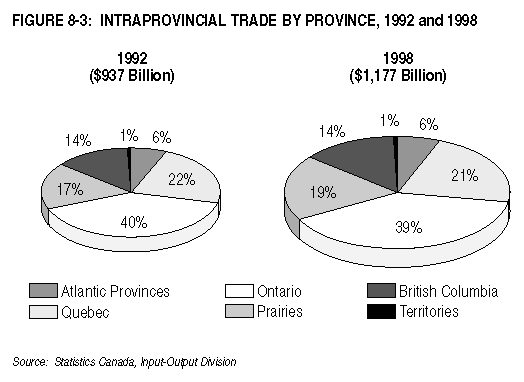
Although less than services, the value of goods traded within
each province rose from $199 billion to $255 billion.
Table 8-3 shows that, in terms of tonnage, for-hire trucking
and rail filled the freight transport demand generated by intraprovincial
trade in 1998. Trucking's share is probably larger than indicated
here, as data on private carriers, owner-operators and small for-hire
carriers were not available.
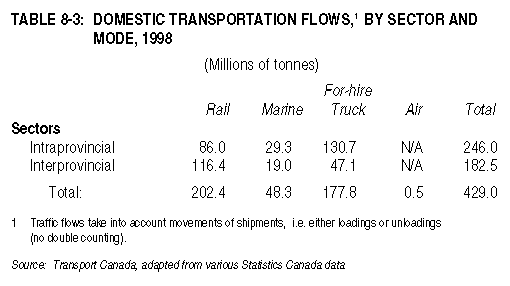
Interprovincial Trade
Although interprovincial trade is a small component of domestic
trade, it is important because it shows economic interactions
between provinces and indicates changes.
From 1992 to 1998, interprovincial trade grew from $134 billion
to $177 billion at an average annual increase of 4.7 per cent.
As opposed to intraprovincial trade, goods dominated with nearly
60 per cent of the total, with services having 40 per cent.
In 1998, major services traded between provinces were finance
and business ($22 billion), trade wholesale and retail ($21 billion)
and transportation ($14 billion). In the same year, the value
of goods moved between provinces was estimated at $102 billion.
Close to 13 per cent of these were primary or crude products (e.g.
mineral fuels). Major traded commodities were food products ($21
billion), machinery and equipment ($17 billion) and mineral fuels
($12 billion). As shown in Table 8-3, rail and for-hire trucking
were the main modes used to move goods between provinces in 1998.
Main East-West Routes
Table 8-4 shows the main interprovincial trade markets and
underlines the strong trade linkages between neighbouring provinces.

In 1998, six two-way interprovincial trade flows, each with
over $10 billion of trade, represented over 70 per cent of total
interprovincial trade. Five of these two-way trade flows had Ontario
as the originating province. The most important interprovincial
trade flows involved Quebec and Ontario and totalled $51 billion,
including $29 billion from Ontario to Quebec. This two-way
route represented 29 per cent of total interprovincial trade.
Other main interprovincial two-way routes were Ontario-Alberta,
valued at $22 billion, or 12 per cent of total interprovincial
trade, followed by Ontario-British Columbia ($15 billion, or eight
per cent), and Ontario-Manitoba/Saskatchewan ($14 billion, or
eight per cent). These share proportions were stable
over the 1992-1998 period.
Figures 8-4 and 8-5 show primary interprovincial trade flows
in 1998.
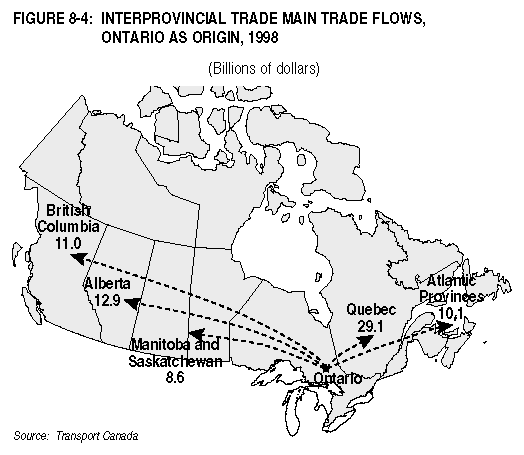
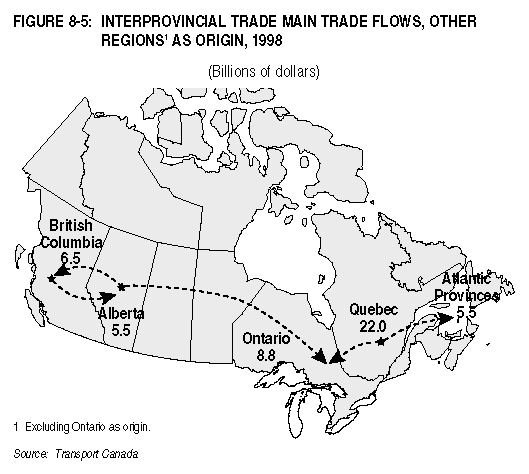
Domestic Trade
NOTES
3
For-hire trucking includes Class I and II carriers earning annual
intercity revenues of $1 million and more, as defined by Statistics
Canada in the "Quarterly For-Hire Trucking (Commodity Origin/Destination)
Survey." Courier and messenger service, private carrier and
owner-operator activities are excluded from the Survey.
4
Starting with 1997, methodological changes were introduced by
Statistics Canada in its trucking surveys to be in accordance
with the new North American Industrial Classification System (NAICS).
As result, the for-hire carriers with annual revenues of $1 million
and more that had more than 50 per cent of their business revenues
driven by local movements (less than 80 km) are no longer surveyed.
|

